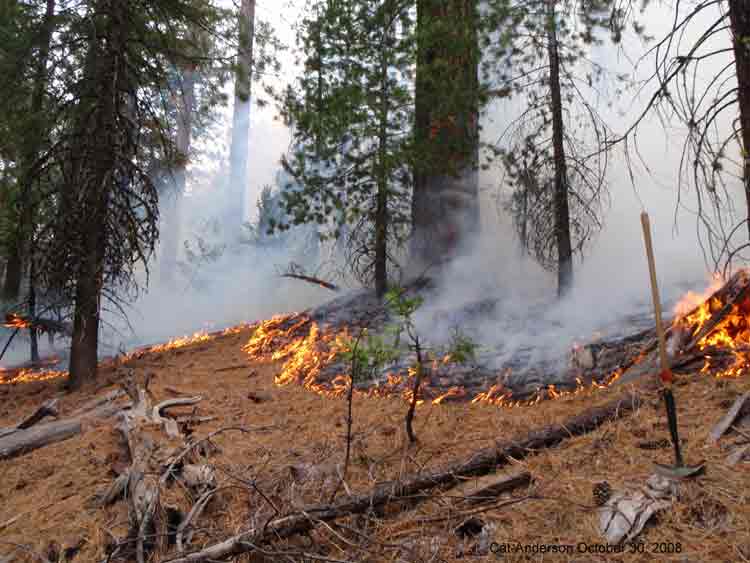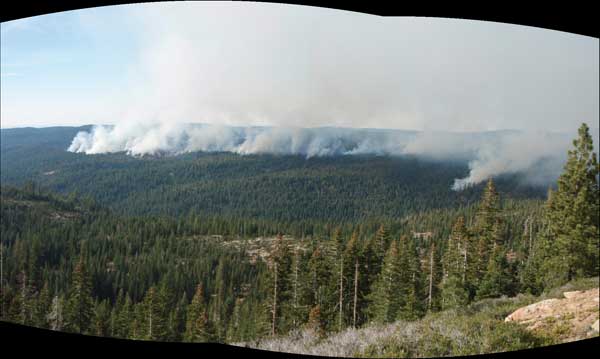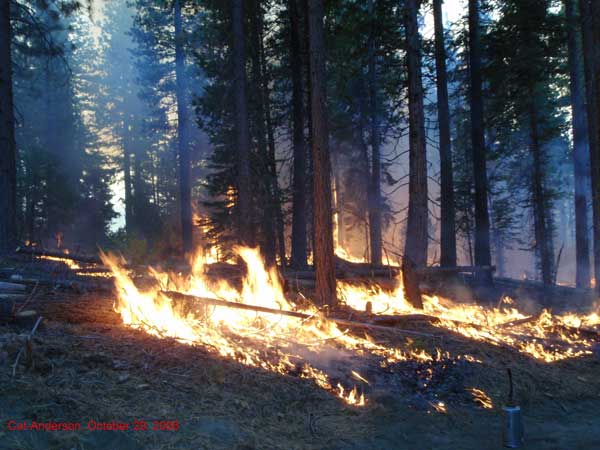Eldorado National Forest
![[Photo]: Low intensity fire burns a dead and down tree. Inset images include a hotshot using a driptorch and a hotshot monitoring a prescribed fire. 2002 Image by Amy L. Reid, USFS.](https://webarchive.library.unt.edu/eot2008/20090114140443im_/http://www.fs.fed.us/r5/eldorado/local-resources/images/0503arch2002alr-f013d-12,0.jpg)
Eldorado National Forest ENF Visitor Information Eldorado Offices - |
|
|
|
Fire and Aviation - Fuels Management"Decades of fire suppression have often produced overcrowded vegetation
in our forest, weakening trees and rendering them more susceptible to
pests, diseases, and displacement by invasive species. Too often, the
result is soil erosion and habitat degradation especially in sensitive
areas such as stream, lakes, and wetlands." Power Fire
October 2004 16,000 acres burned Cost: $8+ million To protect the homes and improve the health of the forest, we must reduce the fuels. Right now many places on the forest are set up for an intense wildland fire. There is extreme fuel loading, a greater density of dead and dying trees, and more structures in the forest. We have a hot, dry windy climate, steep topography and numerous fire starts, both human and natural. Climate and topography we cannot change. Fuels we can modify and we can educate the public on fire safety. In turn, firefighter safety will increase and the loss of structures will decrease. Vegetation that allows the fire to move from lower fuels into higher fuel layers is called ladder fuel. Flames from the fuels at the ground level, such as pine needles, can be carried into taller fuels, such as a shrub, which can ignite still taller fuels, such as tree branches. You need to reduce the ladder fuels and reduce the accumulation of surface and ground fuels to decrease the intensity of a wildland fire. The benefits of reducing the fuel include a reduced competition for light, moisture, and nutrients. A decreased mortality to the remaining larger older trees and a decrease of insects and disease due to the maintained or increase growth in the healthy trees. Mechanical treatments can be designed to remove or rearrange fuels, prepare areas for future fire applications by removing excessive ladder and surface fuels, and can be especially useful in sensitive areas. Smoke emissions and the fire intensity are reduced through the use of mechanical equipment: mastication, biomass removal, shredding, chipping, and handcut removal. We must use all our tools to communicate the issues and options to reduce the fuel. Doing nothing can have severe consequences on public and private land. Insect, disease, and wildland fires do not recognize property lines. Images of the Cat Anderson Prescribed Burn Project
Photos from October 31, 2008. Fuels Projects for Fall/Winter 2008Approximately 9,000 acres of national forest lands are scheduled to be prescribed burned this fall and winter, in both pile and understory fire application. Pile burning begins after the rains have thoroughly dampened the forest floor and will continue throughout the winter months. The timing of the actual ignition of a prescribed burn project depends on weather conditions, moisture in the fuels we intend to burn, our ability to control the fires, and permission from the local air pollution control district.
Every prescribed burn is designed to minimize smoke drifting into residential areas. Any one with respiratory illness or thinks the smoke might adversely affect them should contact the nearest Eldorado National Forest Ranger Station to be placed on a “sensitive persons” pre-burn notification list. Smoke may continue to be present for days after the fires are started due to the large scale of the projects and will be visible from the Highway 88 and 50. Persons driving in the vicinity of the burns may encounter reduced highway visibility. Prescribed Burn Location Maps by District
|
|
USDA Forest Service - Eldorado National Forest
Last Modified: Monday, 24 November 2008 at 18:13:51 EST


